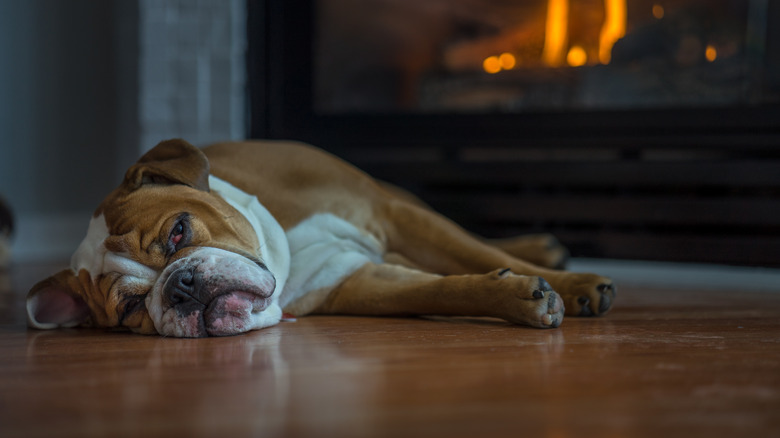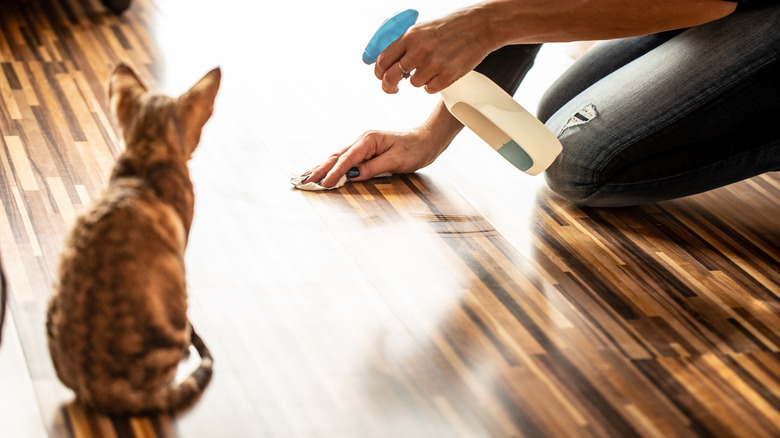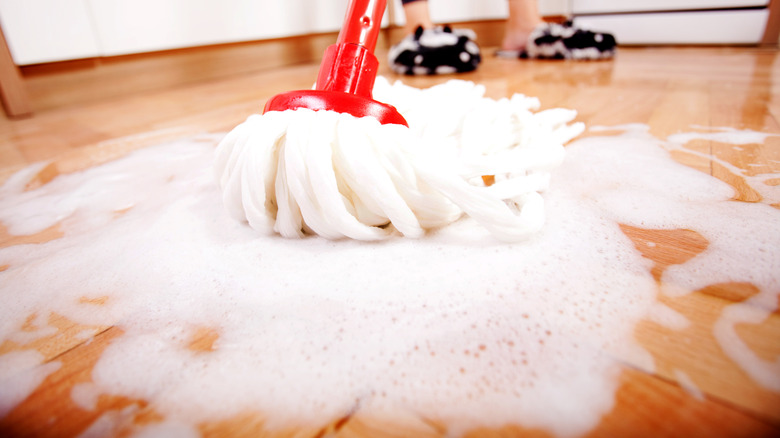How To Get The Stench Of Soaked-In Pet Urine Out Of Hardwood Floors
Wood is naturally absorbent, sucking up just about anything that spills on it. When your pet has an accident, getting urine out of hardwood floors becomes challenging. Though there are a few prevention strategies to consider, once the damage is done, you can use hydrogen peroxide to get the scent out. You'll want to remove the urine as quickly as possible. Once that's done, this at-home solution will work to reduce the lingering odor present in most cases.
Often, hardwood floors have a protective coating on them to limit this type of moisture absorbency, but even when that's present or when you have water-resistant flooring in place, there's still the risk of urine seeping into the cracks and creating a much bigger problem. This hack for removing the stench from soaked-in pet urine works well, but if the scent continues to linger after a few rounds of cleaning, there may be moisture trapped under the wood floorboards, and the only real way to clean this fully is to remove the flooring. The good news is that's not often the case, especially if you treat this problem quickly. Doing so will help to preserve your floors and get rid of any icky scent that's stuck around for too long.
Start with cleaning and treating the scent
React as soon as you spot that puddle on your floor. By using an absorbent mop, towel, or paper towel, you'll remove the fluid from the surface. Aim to blot it dry rather than scrubbing it into the wood. Avoid adding a lot of water to the surface at this point since it could just push the urine deeper into the space under the wood. Once you have most of the fluid cleaned up, mop the area with a damp, clean mop or use a wet cloth to wash the exterior of the surface, getting into all of the grooves, especially along the baseboards.
Next, to tackle the smell, you'll want to put hydrogen peroxide and a few teaspoons of dish soap in a spray bottle. Spray generously on the surface and allow it to penetrate into the wood. The chemical reaction will help to neutralize the lingering odor from the pet urine. Because the wood could warp from too much moisture, avoid completely saturating the area. To be safe, you can also spray the cleaning mixture into a towel and then wipe the surface by hand, allowing you to control more of the liquid. Make sure to use a dry towel to absorb all of that moisture back up. Chances are good it will be a yellowish color.
Further treating pet urine smells
If the scent still lingers, which is somewhat common, especially with the potency of cat urine, you can add baking soda to the process. After following the previous steps, cover the area with a light layer of baking soda and allow it to sit. The baking soda's natural ability to absorb not just fluid but odors will help to bring that pet urine up and out from your wood. Leave it for several hours or overnight. Make sure to apply it only after the surface is dry, or you'll have more of a paste to clean up later.
If, after wiping up the baking soda, there's still the presence of a lingering urine order, a final tip is to use diluted white vinegar on the surface. You need about a 1/4 cup of white vinegar in about a gallon of water. Saturate a towel with it and then wipe down the area surrounding the pet urine. Make sure to go some distance from the original spot since urine can spread into the wood and move outward. Vinegar isn't always the best option for hardwood floors when used consistently because it can eat away at the surface, though it can be used sparingly in situations like these.


